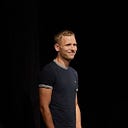Design’s new medium– interview with an AR design convert
I had a quick chat with Mathew Kelcher, a designer who has moved into the augmented reality (AR) space. We discussed his journey into the field, how he approaches his work and his vision of the future. The rest of the article is in Mathew’s words.
Quick links
- Journey into an AR career
- Do you work specifically with one app or device?
- Example of your AR design
- How do you approach AR designs?
- What are the pain points for augmented reality?
- What would improve the space?
Journey into an AR career
Not so long ago, I was hardly interested in augmented/mixed reality. I associated it with virtual reality and I had a mental block around its usability. The idea of wearing a mask for prolonged periods of time and replacing your actual surroundings didn’t appeal to me.
Apple’s decision to include backwards-facing lidar sensors on the iPhone 12 was a shifting point. I was intrigued. Why would Apple decide to add this little-known technology to a mass-market product ?
That got me thinking about the potential for augmented reality. Of course I was familiar with AR, but mostly for what I call inwards-facing experiences like the AR face filter effects.
I took Apple’s release as a sign that we are moving towards mass-adoption of outwards-facing AR. Overlaying digital objects onto our physical environment and being able to interact with them. Suddenly, the possibilities seemed huge.
Do you work specifically with one app or device?
I mostly use Unity and Vuforia. Unity has the most flexibility and it was the best choice for experimenting with digital overlays.
I don’t own a headset. But that will probably change when Apple announces theirs. For now I experience AR like most of the world does, through my phone.
Example of your AR design
I suppose that the Rouge Sur Mesure app we designed for YSL Beauty is an example of where my 2D and 3D design lives came together.
The app connects to a personal lipstick printer. Users can print custom lipstick shades from their phone. Here, AR is used to ‘try on’ the lipstick virtually. You can see the lipstick shade on your lips before you print it.
How do you approach AR designs?
Early discovery
For the Rough Sur Mesure, we started researching how people actually go about trying on real lipstick. We learned a lot and everything was mapped to a journey.
Concept
When I arrive at a concept, I write it out or draw a storyboard to describe the experience and bring it to life.
Feasibility
I’ll take an inventory of what I know and what I would need to learn in to build the experience. I determine where I have the least knowledge and start with the hardest part.
Asking for help(!)
I often consult expert resources. We are lucky to have access to tons of tutorials and resources online.
What are the pain points for augmented reality?
Augmented reality design requires a mindset shift
As a 2D designer I created experiences within a frame (any four sided format, most often a screen), with AR the frame is gone. Any inherited wisdom from conventional design is less useful.
The industry is fast-moving
There is so much information available and there are so many platforms. New things are happening every day. It is exciting, but painful to feel so slow when everything is changing so rapidly.
What would improve the AR space?
Exploit the gap between novelty and applied AR
There is still a lot for us to define. On the one hand there are the mass-adopted social media camera filters and games like Pokemon Go. On the other side, lesser-known applied AR for medicine and the heavy industry.
Designers will have a role in defining what joins the different strands of augmented reality. Otherwise, the big players (hello, Metaverse) will impose their view of AR’s future.
Work together as AR grows quickly
The other improvement I would make is awareness. As this mixed reality universe expands, we need to surround ourselves with other designers to share, learn faster and understand how to enhance the impact of our work.
What is matchboxxr?
I hope you found this post valuable. As the founder, I feel I should mention matchboxxr. Matchboxxr is an online tool to create and share simple, interactive XR/VR prototypes.
Turbo charge projects, reduce the risk of mistakes and empower non-developers to articulate ideas.
At the time of my writing this, matchboxxr is running a beta program for potential users to freely test our software in exchange for feedback. Please get in touch if you think you would find this useful.
